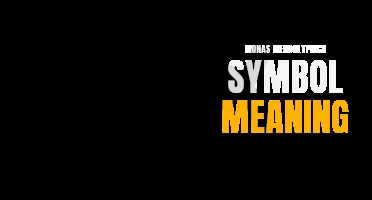
The succubus, a symbol steeped in mystery and allure, has captivated the human imagination for centuries. Representing desire, seduction, and the shadowy realms of the supernatural, the succubus symbol holds a unique place in folklore, mythology, and popular culture. With its origins intertwined with themes of temptation and the eternal battle between good and evil, the succubus symbol meaning dives into the depths of our primal desires and explores the complexities of our darkest fantasies. Join me on a journey into the enticing and enigmatic world of the succubus symbol, where the line between pleasure and danger blurs, and where the fates of mortals may hang in the balance.
What You'll Learn
- What is the meaning and symbolism behind the succubus symbol?
- How has the perception of succubus symbolism changed throughout history?
- What are some common motifs or elements associated with succubus symbols?
- How do different cultures interpret and understand the symbolism of succubus figures?
- In modern culture, what are some examples of succubus symbols and their meanings?

What is the meaning and symbolism behind the succubus symbol?
Succubi are supernatural creatures that have long captivated the human imagination. These female demons, often portrayed as seductive and alluring, appear in various mythologies and folklores around the world. The name "succubus" is derived from the Latin word "succubare," which means "to lie beneath." The symbolism behind the succubus symbol is complex and multifaceted, reflecting different interpretations and beliefs.
In many cultures, succubi are seen as malevolent spirits or demons that sexually prey on unsuspecting men, draining their life force or even their souls. They are believed to visit men in their sleep and engage in sexual relations, which can lead to illness, madness, and even death. This symbolism stems from the fear and anxiety associated with female sexuality and the power it holds over men. The succubus represents a dangerous and uncontrollable aspect of desire and lust.
The succubus symbol is often depicted as a seductive woman with devilish features, such as horns, wings, or a tail. These physical attributes emphasize their otherworldly nature and their connection to the demonic realm. The symbolism of these features often serves to warn men of the temptations and dangers of giving in to their desires. The succubus symbolizes the allure of forbidden pleasures and the consequences they can bring.
However, some interpretations view succubi as more complex and sympathetic figures. They are seen as entities that embody female power and sensuality, challenging traditional gender roles and societal norms. In this context, the succubus symbol becomes a representation of female empowerment and sexual liberation. It challenges the notion that female desire is something to be feared or suppressed, highlighting the importance of embracing and celebrating one's own sexuality.
The succubus symbol can also be seen as a metaphor for the internal struggles and conflicts within individuals. It reflects the inner battle between temptation and self-control. Succubi represent the desires and impulses that we may find difficult to resist, urging us to confront our own inner demons and make conscious choices.
In art and literature, the succubus symbol has been used in various ways. It has been depicted as a femme fatale, a seductive and dangerous woman who leads men to their downfall. It has also been portrayed as a misunderstood and tragic figure, longing for love and acceptance. The succubus symbolizes the complexities of human desires and emotions, exploring the blurred boundaries between good and evil, pleasure and pain, and love and lust.
In conclusion, the succubus symbol carries a range of meanings and symbolism. It represents the fear of female sexuality and the dangers associated with desire, but it can also embody female empowerment and the celebration of sensuality. It serves as a reminder of the internal struggles and conflicts that individuals face, urging them to confront their desires and make conscious choices. Ultimately, the meaning behind the succubus symbol is a reflection of our own fears, desires, and understanding of the human experience.
The Deep Meaning Behind Huichol Symbols: A Fascinating Exploration of Huichol Culture
You may want to see also

How has the perception of succubus symbolism changed throughout history?
Succubus symbolism has undergone significant changes throughout history. In many ancient cultures, succubi were seen as malevolent entities, often associated with demonic activity and nocturnal sexual encounters. However, as society evolved, the perception of succubi shifted, and they became more nuanced figures, often portrayed as seductive and powerful beings.
In ancient Mesopotamia, succubi were known as "Lilith," derived from the Sumerian word "Lilitu," meaning "wind spirit" or "night demon." Lilith was described as a demoness who preyed upon men, seducing them in their sleep and causing harm. This negative perception of succubi persisted in other ancient cultures, such as ancient Greece, where succubi were depicted as female spirits or demons who drained the life force of men through sexual encounters.
During the Middle Ages, when religious beliefs held significant power over society, succubi were often viewed as demonic figures tempting men away from their religious duties and leading them into sin. As a result, succubi were depicted in religious artwork and literature as dangerous temptresses, luring men into immorality.
However, towards the end of the Middle Ages, the view of succubi began to shift. Renaissance artists and writers, influenced by classical mythology and the rediscovery of ancient Greek and Roman texts, started portraying succubi as beautiful, seductive beings with supernatural powers. This shift can be seen in the work of artists like Hieronymus Bosch and poets like Dante Alighieri, who portrayed succubi as enchanting figures capable of captivating men with their allure.
In subsequent centuries, succubi continued to be portrayed as powerful and seductive beings in various forms of art and literature, such as the works of John Milton and Johann Wolfgang von Goethe. These representations often emphasized the duality of succubi, highlighting their ability to both tempt and empower men.
In recent times, succubi have found a new home in popular culture, appearing in movies, television shows, video games, and literature. These modern portrayals often draw from both the ancient and Renaissance depictions, mixing the seductive allure with elements of power and danger. Succubi are often portrayed as complex characters, with their sexuality often explored as a means of expressing their own desires and agency.
The evolving perception of succubus symbolism throughout history reflects changing societal attitudes towards female sexuality and power. From demonized temptresses to empowered figures, succubi have become a symbol of female sexuality and agency, challenging traditional notions of femininity and morality. Whether seen as dangerous or alluring, the succubus continues to captivate the human imagination and provoke discussions about desire, temptation, and the complexities of human nature.
Exploring the Fascinating World of Moroccan Symbols and Their Deep Meanings
You may want to see also

What are some common motifs or elements associated with succubus symbols?
Succubus symbols have long been associated with the supernatural realm, lust, and temptation. These symbols often embody various motifs and elements that are commonly associated with succubi. Here are some of the most common motifs or elements associated with succubus symbols:
- Female Figure: Succubus symbols usually depict a seductive and alluring female figure. This figure is often portrayed as beautiful, with exaggerated feminine features, such as curvaceous body, long hair, and seductive eyes. The female figure represents the temptress nature of the succubus, using her appearance to entice and seduce her victims.
- Bat Wings: Many succubus symbols feature bat wings as a representation of their association with the supernatural. These wings symbolize the succubus's ability to fly and move swiftly, as well as their connection to the nighttime and the shadows. The bat wings often add an aura of mystery and dark allure to the overall symbol.
- Horns: In some representations, succubus symbols include the addition of small horns on the female figure's forehead. These horns symbolize the demonic nature of the succubus, as they are reminiscent of demonic or devilish beings. The horns also add an element of danger and wickedness to the symbol.
- Tail: Another common element associated with succubus symbols is a tail, usually depicted as a serpent-like or devilish tail. Much like the horns, the tail represents the demonic nature of the succubus. It serves as a reminder of the temptress's ability to deceive and manipulate her victims.
- Tridents and Pitchforks: These symbols are often added to succubus symbols to emphasize their association with the devil or the underworld. The trident or pitchfork serves as a weapon or tool that the succubus might utilize to further seduce and harm their victims. It adds an element of danger and power to the overall symbol.
- Red and Black Colors: Succubus symbols are often depicted using red and black colors, as these hues are commonly associated with lust, desire, and the darkness of the underworld. Red represents passion, while black represents mystery and the unknown. These colors evoke a sense of danger and seduction, which is a key element in succubus symbolism.
Overall, succubus symbols often incorporate motifs and elements such as a seductive female figure, bat wings, horns, tail, tridents or pitchforks, and red and black colors. These symbols serve to capture the essence of the succubus, representing their demonic nature, seductive allure, and association with the supernatural realm.
Decoding the Bobcat Warning Light Symbols: Understand Their Meanings
You may want to see also

How do different cultures interpret and understand the symbolism of succubus figures?
Succubus figures are known to exist in various cultures and are often associated with seduction and sexuality. These beings are believed to appear in dreams and possess the ability to drain the energy and life force of their male victims. While the concept is similar across cultures, the interpretation and understanding of succubus figures can vary significantly.
In Western culture, succubi are generally portrayed as demonic entities that seduce men in their sleep, primarily for the purpose of extracting their life essence. These figures are often depicted as beautiful women with wings, horns, and a tail. They are seen as symbols of temptation and are associated with the deadly sin of lust. In this context, succubi are seen as metaphors for the dangers of unchecked desire and the consequences of giving in to one's carnal urges.
In contrast, some Middle Eastern cultures have a different interpretation of succubi figures. In Arabian mythology, these entities are known as "Qarinah" and are considered to be a type of jinn, or supernatural being. Qarinah is believed to take the form of a beautiful woman and seduce men, but their purpose is not solely to drain their life force. Instead, they are thought to become the lovers or wives of these men, forming a lifelong bond. In this context, succubi are seen as symbols of passion and desire, representing the allure of forbidden love and the dangers of straying from societal norms.
In certain Asian cultures, such as Japan, succubi are known as "Succubus Kitsune" or "Yokai," which are supernatural fox-like creatures. These beings are often depicted as shape-shifters who can take on various forms, including that of a seductive woman. Unlike their Western counterparts, Succubus Kitsune are not necessarily associated with evil or malice. Instead, they are often seen as playful tricksters who enjoy teasing and seducing their victims. In this context, succubi are seen as symbols of mischief and the unpredictability of human desires.
Overall, the interpretation and understanding of succubus figures vary across cultures. While they are generally associated with seduction and sexuality, the specific symbolism and context surrounding these entities can differ significantly. Whether as symbols of temptation and lust in Western cultures or as representations of passion and desire in Middle Eastern cultures, the concept of succubi figures continues to captivate and intrigue people worldwide.
Unraveling the Mystery: Exploring the Symbols and Meanings of Pysanky Eggs
You may want to see also

In modern culture, what are some examples of succubus symbols and their meanings?
In modern culture, the succubus is a popular mythical creature that often appears in various forms of media, including literature, movies, and art. Derived from medieval folklore, the succubus is depicted as a female demon who seduces men, usually while they are sleeping, and drains them of their life force or sexual energy. While the concept of the succubus has evolved over time, several symbols associated with this creature have emerged in modern culture and carry specific meanings.
One of the most common symbols associated with succubi is the use of wings. In many depictions, succubi are portrayed with large, bat-like wings sprouting from their backs. These wings symbolize the succubus' ability to traverse between the realms of the living and the supernatural. Additionally, the wings symbolize the succubus' connection to the night and darkness, as well as their capacity for flight. The wings represent freedom, independence, and the ability to transcend earthly limitations.
Another symbol often associated with succubi is a tail. Typically depicted as a serpent or demon-like appendage, the tail symbolizes the succubus' seductive and manipulative nature. It represents their ability to tempt and ensnare their victims, luring them into their grasp with their charm and allure. The tail also symbolizes the succubus' connection to the underworld and their association with evil forces.
Furthermore, the succubus is often depicted wearing revealing or provocative clothing. This symbolizes their role as seductresses and sexual predators. The attire worn by succubi accentuates their feminine allure and highlights their sexually charged nature. It is often dark or red in color, further emphasizing their connection to the sensual and erotic.
Additionally, the use of horns is a common symbol associated with succubi. These horns represent the succubus' demonic nature and their affiliation with the infernal realms. The horns also symbolize their ability to manipulate and corrupt their victims, as well as their power to control their own destiny. They signify the succubus' dominance and assertiveness, adding to their allure and mystique.
In modern culture, these symbols associated with succubi can be seen in various forms of media. For example, in literature and artwork, succubi are often portrayed with wings, tails, and horns to emphasize their supernatural and seductive qualities. In movies and television shows, these symbols may be depicted more subtly, with costume designs and visual effects hinting at the succubus' otherworldly attributes.
In conclusion, the succubus is a fascinating mythical creature that has found its place in modern culture. Through the use of symbols such as wings, tails, revealing clothing, and horns, succubi are depicted as seductive, manipulative beings with a connection to the supernatural. These symbols not only contribute to the visual representation of succubi but also carry deeper meanings related to their abilities, nature, and associations.
Decoding the Symbols and Meanings of Caterpillar Heavy Equipment
You may want to see also
Frequently asked questions
The succubus symbol represents a female demon or spirit that is believed to seduce and engage in sexual activity with men, usually while they are sleeping. In various mythologies and folklore, succubi are often depicted as attractive women with the ability to drain the life force or essence from their victims.
Yes, the succubus symbol is typically associated with evil or negative energy. Succubi are often seen as symbols of temptation and lust, and their actions are often portrayed as harmful or destructive. They are believed to prey upon men and drain their vitality, potentially leading to physical or mental deterioration.
While the succubus symbol is primarily associated with negative connotations, some individuals may interpret it in a more positive or empowering light. In certain modern interpretations, succubi are seen as embodiments of female sexual liberation, representing the power of female sexuality and desire. These interpretations focus on reclaiming and embracing one's own desires and pleasures.
The succubus symbol has roots in various cultures and mythologies. The concept of a seductive female demon can be found in ancient Mesopotamian, Greek, and Roman mythology. The word "succubus" itself derives from medieval Latin, and the concept evolved and expanded through Christian demonology and folklore.
Yes, the succubus symbol has made appearances in various forms of modern popular culture. It is often depicted in fantasy literature, role-playing games, and contemporary art. Additionally, succubi have been portrayed in films, television shows, and video games, sometimes being reimagined with more complex and nuanced characteristics beyond their traditional role as seductresses.







